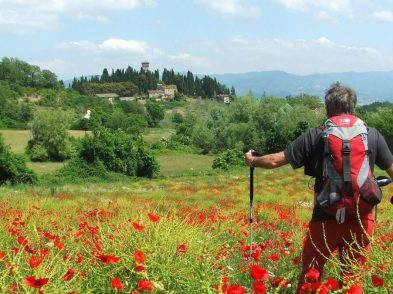‘Barga is a movie set of steep, dark streets lined with houses whose earth-colored walls, in quiet pinks, gentle browns and compliant grays, suggest they haven’t been constructed so much as grown from the hillside.’
The best thing about Bagni di Lucca, northeast of Lucca, is not what it is but what it recalls. Stare into the vapors rising from the 120-degree hot springs and you’ll see images of another epoch: Byron and Shelley taking the waters and writing home to urge Tennyson to do likewise, German poet Heinrich Heine and Irish novelist Charles Lever feeding their muses and perhaps their metabolisms. This spa town above the rushing river Serchio is worth a walk around. Once you cross its Ponte a Serraglio, you’ll be on the road up to another, slower, mistier, mossier world of sulfur fumes and sleepy hollows. It was November when my friends and I were there. One of the springs was closed for the season. Hardly anyone was around. We had the road to Bagni Caldi and the adjacent Stabilimento Jean Varraud all to ourselves—ourselves and a black cat that stalked us long enough to be bored by our company and seek excitement elsewhere in a bit of string.
Near the top of the hill is the early-20th-century Stabilimento Jean Varraud, a labyrinth of steam baths, massage rooms, exfoliation chambers and swimming pools. We crept in fully clothed and unannounced and somehow managed to explore the establishment thoroughly, ignored by chunky men in terrycloth robes and flip-flops who passed by like wraiths before they disappeared behind unmarked doors, leaving in their wake a puff of sulfur. We felt like Dante exploring Purgatory.
More evocative even than the Stabilimento’s springs or its long history of ‘taking the waters’ is its casino, now a preserved room filled with gaming tables, where clients came to relieve the tedium of sitting in the grotta a vapore and afterwards lying face-down in a white sheet and an uncomfortable blanket, breathing in. One table, covered with images of cards, is monogrammed with the name Caribbean Spud—which sounds more like a potato than a card game. The walls of the casino have been scraped to reveal layers of yesterdays. It is a ghostly room, well suited to the bath-robed spirits that flit from bath to bed without so much as a buongiorno.
Fifteen kilometers away is the town the guidebooks say is the prettiest in the Garfagnana. They’ll get no argument from me. Barga is a movie set of steep, dark streets lined with houses whose earth-colored walls, in quiet pinks, gentle browns and compliant grays, suggest they haven’t been constructed so much as grown from the hillside. I say all this having seen Barga in a pouring rain.
If ever a town had its head in the clouds, it’s Barga. The day was gray when we arrived, grayer when we stopped for lunch in a fine little restaurant just inside the city walls and, after linguine al tartufo and a defensible local wine, pouring with rain. The 12th-century Duomo, perched at the very top of the town, is the jewel in Barga’s crown. We marched Duomo-ward, never minding that the rain came harder with each step, and wave after wave of water washed down the tilted streets under our feet. The piazza in front of the Duomo could have afforded a stunning view of the Garfagnana landscape. But as we looked into a gray mist in tutti direzione, it was as if the Duomo were floating in a cloudy sea.
Inside, a few euro in a coin box illuminated a 15-foot-high marble pulpit sitting on columns supported by a pair of patient lions. Above the altar was an imposing 12th-century, multi-colored wood carving of St. Christopher, with the Christ child portrayed as a miniature king, crown and all, sitting up properly on his shoulder. In the chapel to the right is a pair of Della Robbias worth the walk in the rain. In the chapel to the left are two ordinary paintings, one to the Glory of the Madonna by the school of Simone Pignoni and one a grisly beheading scene of St. John the Baptist by Baccio Ciarpi-and the walk-away best in show, a crucifixion by an unknown maestro of Barga hung inconspicuously on the chapel wall. (But then I’ve always been a pushover for unknown masters).
The walk back down the paved hillside was slick. We stepped carefully to avoid losing our footing. Every now and then we would stop and stare upward at a corner of the town where the roofs cut into the sky to make a collage of tile and gutter spouts. When a town begins to paint its own pictures, you know you’re in a special place. See Barga whatever the weather, but make a special effort to see it in the rain.




